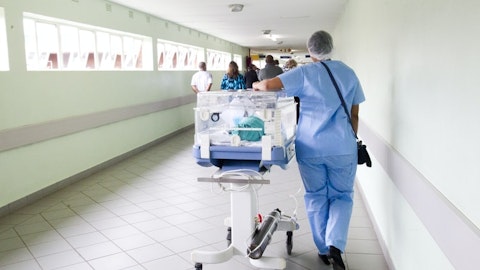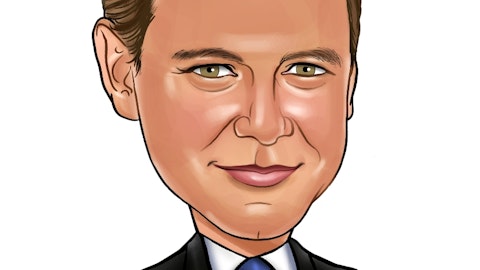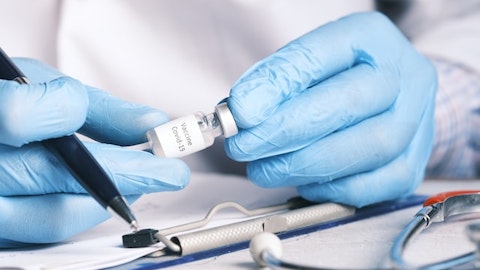Richard Barasch: Okay. This is Richard. First off, we’re not seeing any attrition and any effect in diabetes relative to any perception of GLP-1 utilization. The issue that we have been dealing with is the shift in channels more than any attrition. What our strategy is to work in the pharmacy channel with payers, but the key to that will be to add value in the way that we generate data for the utilization of the payers. We believe that both manufacturers and payers will care about this and will help us to improve our margins in the pharmacy channel.
Jason Clemens: Yes, Matt, I’d add a little color. Certainly, at the top and bottom line financials on a unit economics of a pharmacy patient is typically less than the traditional medical benefit or DME channel. But as Richard said, we see tremendous value in aggregating patients and covered lives within diabetes, In Richard’s prepared remarks, he spoke about the first steps that we’ve taken this quarter in actively monitoring CGM data produced from devices of our patients. We have deployed certified diabetes coaches with that data, engaging with patients. Initially, we really focused on sensor and overall utilization. And so what are the reasons that a patient was set up last month, and you’d expect a new sensor to be applied in the first 10 to 14 days, depending on the manufacturer.
But a month later, we’re not seeing the data communicated on that CGM. And so we’re working hand-in-hand with those patients, and we’re learning a lot about patients that are on initial setup that might not be in compliance. So compare this to the capability we already have with over 350 sleep coaches in our business that all day, every day are monitoring data produced from equipment and these devices to help patients along their journey with resupply. We intend to do more there, additionally monitoring A1c levels, hypoglycemia levels, just the rich level of information that’s produced from these CGMs. We don’t think that needs to be a medical benefit channel strategy or a pharmacy channel strategy. We think it’s an all-encompassing diabetes strategy.
Mathew Blackman: Got it. Thank you and apologies again for the chunky questions. Thanks so much.
Operator: [Operator Instructions] And our next question comes from Pito Chickering with Deutsche Bank.
Pito Chickering: Hey, good morning guys. So I apologize for another question on Humana. Maybe I’m just being dense here. So for that, I do apologize ahead of time. But is a capitated arrangement and you capture the patients back to competitors in order to build PMPM, and that’s where you sort of mismodeled. So if I understand it, to get the CAP payments, you have to go recap this payments back within Adapt. I’m just saying like how are you able to shift those patients? Can you do that without patients consent? Patient perspective, if provider for one or two years, I guess, why would they want to change?
Jason Clemens: Sure, Pito. Good question. Well, firstly, if you’ve been the DME provider for a number of years, you absolutely will not want to change. However, as part of the mechanism of the contract, those competitors in these 33 states in the District of Columbia as we stand here today are not authorized. I mean, they’re out of network, right? They’re not authorized to build fee-for-service for these patients. On the rental lines, however, that’s really where the nuance is. The lifting and shifting a patient is — it is more complicated than we anticipated. Now we, in some cases expected just either better or more thorough documentation maintained by competitors that just isn’t there. And so in that instance, that requires us to work directly with the patient and with the patient’s provider to work backwards, if you will.
Like an oxygen patient tracking down the saturation testing to support the therapy and the referral. And so without getting into just layers and layers of detail, that is an example of what needs to happen in order to transition those patients. But we have invested in additional resource and capability just in the last several weeks, and we are already seeing ramp week-over-week in our patient transitions.
Pito Chickering: Okay, fair enough. And then shifting to diabetes, it’s going to be sort of multipart, so I apologize again. What percent of revenues in diabetes are CGM versus pumps at this point? What’s the breakout between commercial and Medicare sort of within the segments? And if I look at CGM, what did Medicare CGM grow this quarter, what did commercial CGM grows this quarter? I’m trying to bridge DexCom’s U.S. revenue growth sort of what you guys saw in the Medicare book of business?
Jason Clemens: Sure, Pito. Yes, that’s a complicated question. I’d say firstly, the delineation between pump and pump supplies versus our CGM business. We’ve been on record saying that pump and pump supplies was about $160 million of revenue last year and that we believe it will be about $120 million of revenue this year. That’s the $30 million to $40 million compression we’ve been talking about, just that headwind created by the med tech and the tubeless based pump on the market. The rest of the business is CGM business. As Richard said in his prepared remarks, government payers made up now 79% of that census. So that’s up another two full points sequentially from the second quarter. I mentioned that CGM census was up 4.3% in the third quarter and resulted in about flat revenue.
And so what you’re seeing there is continued but less reimbursement pressure created by a movement of traditional government payers and the medical benefit channel versus commercial. So as we’re taking care of fewer commercial patients in exchange for taking care of more government patients, we will continue to see a reimbursement headwind. But for this quarter, our volume was enough to offset that pressure.
Pito Chickering: Okay. Just specifically looking at CGM Medicare. I guess, how much did that grow — that segment grow year-over-year?
Jason Clemens: It was up about higher single digits, and then offset by lower single-digit commercial. And then you’ve got the rate equation to get you to about flat revenue.
Pito Chickering: Okay. So from a market share, again, only focusing on Medicare, ignore sort of commercial MA for a second. Do you think you’re gaining or is losing share within the Medicare CGM market? Thanks so much.
Jason Clemens: Sure. We are gaining patients certainly. I think it’s tough to delineate are we gaining share or not from that. But certainly, we’re gaining patients. We are very aggressively recruiting new sales reps for really selling CGM and other diabetes products. We’re really selling CGM in just key markets, key geographies. We spend a lot of time thinking through the data over the last two quarters about where we want to go strong in adding sales reps. So we do expect that government business growth to resume in the fourth quarter.
Pito Chickering: Great, thank you so much.
Operator: We have our next question from Richard Close with Canaccord Genuity.
Richard Close: Yes, thanks for the questions. Jason, I’m just curious if you’ve reaped all the benefits from the system upgrades and restructuring from the last couple of years. If you can give us an update there?




